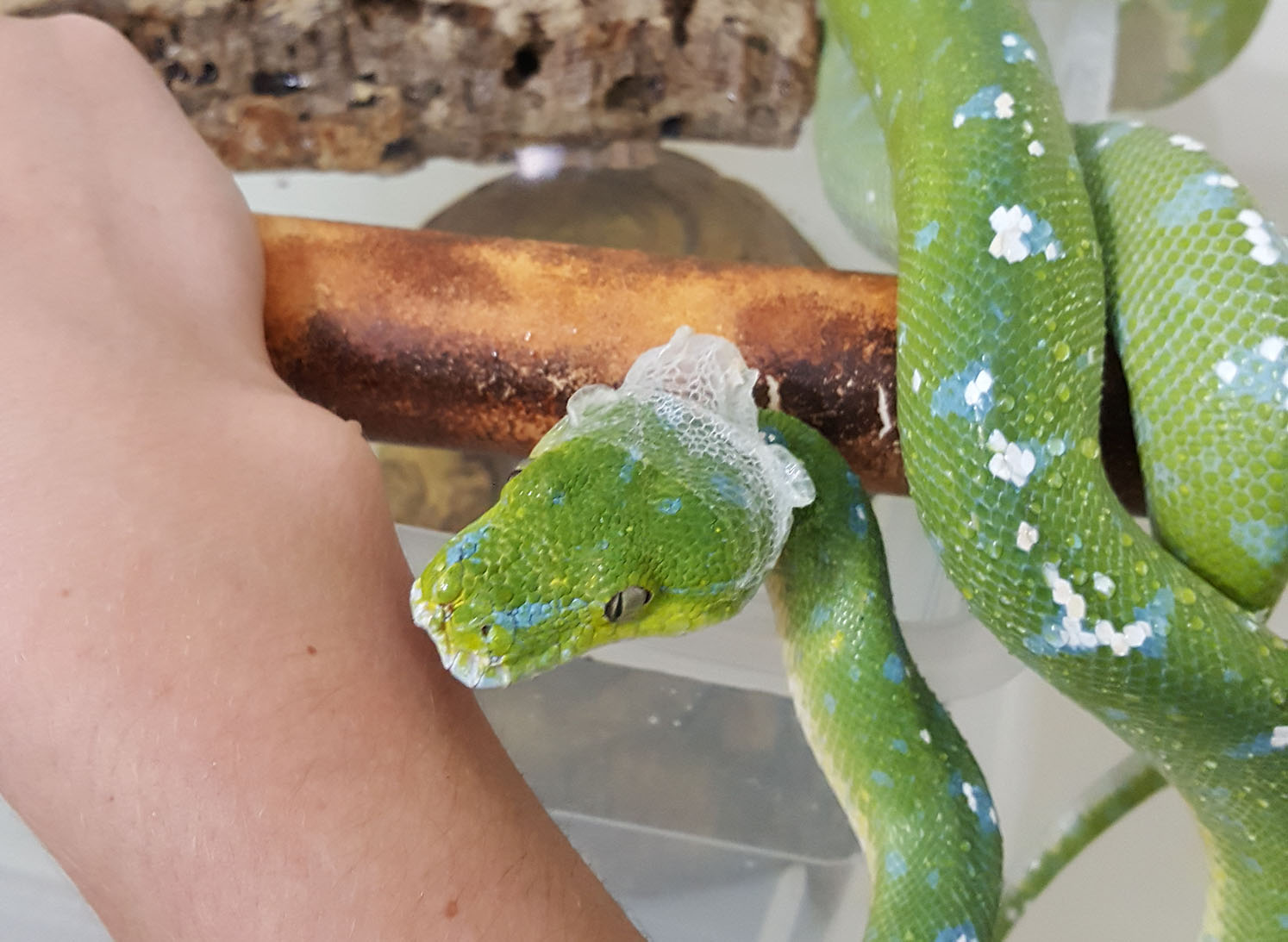Bad sheds in snakes
First, it is important to recognize a bad shed. It is most helpful if you make note of when the shed cycle starts, and you can get an idea of about how long your snake takes to complete its shed. For instance, you can recognize when many ball pythons are in “pre-shed” (that is, about to start the shed) if the belly is pink all the way down. In lighter-colored snakes, the entire body may take on a pink-ish color.
Know your snake
Younger snakes shed more frequently, and smaller snakes will take less time to shed. Our adult tricolor hognose sheds almost exactly every four weeks. Subadult ball pythons may shed every 1-2 months and take about 7 days. Larger specimens, like adult carpet pythons, may shed every 3-4 months and take 10-13 days to shed. If you track these things, it will be much easier to know when to be concerned.
Recognizing a bad shed
A snake with stuck shed may have a dry, wrinkly appearance. You may see them rubbing their nose unsuccessfully on décor. They may not shed at all, or they may “explode” with bits of shed all over the substrate.
This is not to be confused with a snake that is ready to shed, but doesn’t want to. Some snakes will remove the face-part of their shed and stop, perch, and stare at you like it’s not their problem. You can determine if the shed is ready to come off by gently rubbing with your finger, with the scales (head to tail). If the skin rolls tailward easily, you can simply assist them out of the shed.
Shed is stuck
NEVER force off a stuck shed, particularly over the spectacle (eye) of the animal. You can cause irreparable damage to the eye.
Understand that this is not a substitute for proper humidity and timing. You cannot get back the preparation time the snake uses—and needs—to have a successful shed. So, if the shed is stuck you are at a disadvantage. It is important to recognize this, and work patiently, and do better next time.
There are a few things I like to do to deal with a stuck shed. This is for a moderate to high humidity snake, like a ball python.
Soaking-
- prepare a latching soaking tub with water as deep as the snake is thick
- the tub should be clear, and the snake should be supervised
- water temperature should be around 81-86F
- for smaller or younger snakes, you can put a layer of paper towel at the bottom of the tub. This will give the snake something to touch and may lessen stress.
- you can add some shed-ease to the water
- soak the snake for 20-30 minutes. After soaking, check the snake. Rub your finger on a patch of skin. If it starts to come off, you may only need to assist the snake with the rest of its shed (you can also put it back in the enclosure and see if the snake sheds on its own). For at-risk snakes, we may use less water, anywhere from one-half the snake’s thickness to just enough water to cover the bottom of the tub. If the shed is still stuck after soaking, move to a humidity tub.
Humidity tub-
- prepare a latching humid tub with substrate, preferably eco earth. Make it wet, and mush it flat (it should be wet, but not pooling water)
Note: Remember that “wet” substrate is NOT recommended for a daily enclosure setup. This “wet” setup is for temporary use only
- the tub should be clear, and the snake should be supervised
- add a clean rock or piece of décor with a rough/textured surface
- place the tub somewhere warm, where the snake can sit at about 80-85 degrees.
- let the snake sit for 30 minutes to 1 hour
-
After sitting, check the snake again. You may need to soak again. You can alternate methods, but do not leave a snake to soak too long as it is more likely to stress/tire them out.
Always monitor your snake’s stress level. If the snake becomes too stressed, you may need to return to the enclosure (which should be sprayed and at appropriate humidity for the species) and try again in a little while.
Assisting/manual shed removal
If you can assist in shed removal (meaning the shed is pliable and moves relatively easily when rubbed), a damp paper towel may help with removing the shed. Having two people is very useful here—this way, the snake has somewhere to go and can be distracted while the other person works on the shed. If you are working alone, I advise sitting on the floor.
If the face/eyecaps are stuck, use the rest of the body as a guide for when to try assisting removal of face shed. If the body shed is coming off easily, the face shed should be about ready. Ideally, you should rub at the nose or lips of your snake and work the entire facial part off in one piece.
Your snake is probably not going to like this. It is best if you can get the shed loose and let them work the face shed off on their own. If you do assist removal of the face shed, be patient. When you get to the eyecaps, the snake may become nervous because again, temporarily, it will be hard to see with skin folded over the eyes. Go slowly and do not force anything.
Be sure to let your snake rest after working with it and after the shed is complete. For a very stressful adventure, it may be best to let the snake rest for 24 hours in its enclosure before attempting feeding.
If you’ve had a rough shed, make sure you evaluate your husbandry and do everything possible to ensure that the next shed is a successful one.



